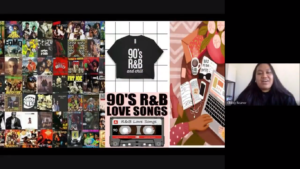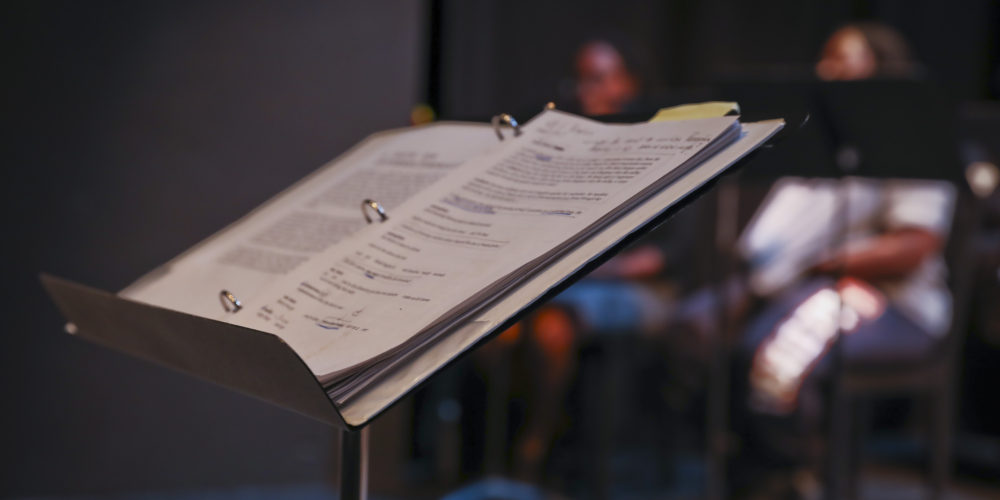09 Jul The Making of a Virtual Play Festival: The Blog
BAPF Behind the Scenes: Welcome & Pecha Kucha
Written by Lucas Nash

Katie Gubler presents her Pecha Kucha to the cohort
Welcome to the blog for Playwrights Foundation’s 2020 Bay Area Playwrights Festival! I’m Lucas Nash, the Festival documentarian fellow, and I’m excited to provide a behind-the-scenes look into the process. Currently, our world is forced to address both the ongoing COVID-19 pandemic and the realities of police brutality and racial injustice. Dialogue is necessary, but can be difficult to create in these isolating times. The theatre will always be a place for conversation which has been happening in our virtual office. Playwrights Foundation’s mission is to support and champion diverse contemporary playwrights, and we won’t allow quarantine to stop us. Thus, we are taking BAPF online for the first time. It’s a wholly new endeavor for us and I’d like to share a bit from the perspective of our interns.
Our interns and fellows, whom we have deemed The Cohort, hold an interesting position at PF. Although each intern has a role (marketing intern, artistic intern, etc.), our activity extends beyond our assigned departmental duties, and we often assemble to collaborate on large projects. A collective vision directs our combined efforts, but each team member’s interests and proficiencies ensure that vision is approached from multiple angles.
Such an instance occurred while creating mood boards for our five new plays. Along with our departmental roles, interns are each assigned to assist one of the artistic teams. For this particular assignment, we created a mood board of images and information relevant to our assigned shows and presented to the group in Google Meets (our office space) in the form of Pecha Kucha. Pecha Kucha is a style of slide show presentation that only allows its presenter twenty seconds to describe each image (typically twenty slides total). The result is an electric sprint rather than a crawl as one might expect from an office presentation.
The cohort’s varied approaches were shown explicitly. By condensing otherwise extensive interpretations into a snapshot, the crux of each slide was provided. It was interesting to note how everyone ascribed meaning within the context of the plays. The contrast between exploring physical and affective qualities was particularly evident. Firstly, some slides contained media that directly addressed production details. Katie Gubler, casting intern, presented location photos of San Diego, Texas, and Mars. These locations are featured in Jordan Ramirez Puckett’s play To Saints and Stars and Katie’s selected photos bring to mind potential stream backgrounds. The photos exuded warmth (yes, even mars), which Katie tied to the climate change occuring in the play. Similarly, Chelsy Ricanor, operations intern, compiled outfit ideas and dorm furnishings to create an aesthetic suited for the college students in Babes in Ho-lland by Deneen Reynolds-Knott representing the character’s safe space. Both Chelsy and Katie created an extensive collection of photos from which aesthetic and thematic elements emerged.

Chelsy presenting potential Babes in Ho-lland aesthetics
In other slides, symbolic images were explored with the potential to create effective change in production vision. Isabella Benning, marketing intern, interpreted the symbolic nature of the sweet pea plant. The sweet pea is known to be a symbol of appreciation and departure which Isabella likens to Eugenia Silva, a character who confronts divorcement from her Uruguayan culture in Noelle Viñas’ play Derecho. Meanwhile, Emily Zhou, artistic intern, presented photos of the symbolic gestures employed by protesters in Hong Kong, the emotions and meaning of which are echoed in Final Boarding Call by Stefani Kuo.

Isabella on the symbolism in Derecho
Of course, the Pecha Kucha slides can not be defined simply by dichotomy. Hailee Foster and Isabelle Smith, production intern and special events intern, collaborated to create a Pecha Kucha for Mingus by Tyler English-Beckwith. They featured the song “Bamboo Flute Blues” by Yusef Lateef, relating it to Harrison, one of the play’s characters, and leaving open the possibility for the song’s inclusion in scene changes or pre-show lobbies.
Ultimately, our cohort pursued this exercise in ways that distinguished everyone’s unique perspectives. We have a team of creatives that are ready to take on the challenges of festival production. While our interns learn from their collective experience, we hope that you as well will enjoy this behind-the-scenes look into the Bay Area Play Festival!



Lloyd Nash
Posted at 23:15h, 10 JulyA very engaging post. I wish I could have clicked to see a Pecha Cucha in real time in this post. I would enjoy getting tickets but living in connecticut I fear that I won’t be able to travel to see it. Will it also have a remote component so that I can enjoy it while remaining on the East Coast? I applaud your endeavors and wish you all the best of luck!
marketing
Posted at 18:54h, 11 JulyHi Lloyd! Our entire festival this year is exclusively online! You can get your online tickets, which will then provide you with a Vimeo link and password, here: https://playwrightsfoundation.secure.force.com/ticket
Brigid Amos
Posted at 15:41h, 12 JulyI love the idea of Pecha Kucha! After a career in soils research, sitting through so many seminars in which people (including me) would drone on about one slide, I wish we could have challenged our scientists to a time limit like that!